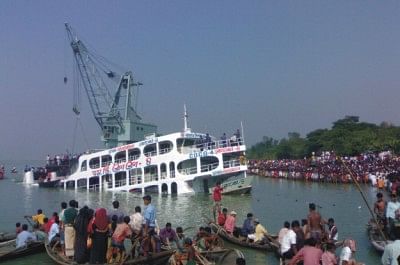Launch disaster

Does anyone really care?Photo: AFP
A media reporter covering the southern districts of the country during the Eid holidays might in advance scribble down in his writing pad a news that reads like: M.L…. sunk/capsized in the river … near … on … with more than … hundred passengers on board. … passengers including women and children feared dead and another … missing. Although the cause of the incident is not instantly known, it is believed to be due to overloading, faulty design and negligence of crew.
The president, the prime minister and the opposition leader have expressed shock and have sent messages of condolence to the bereaved families. The ministry of shipping and IWTA has instituted a three-member inquiry committee to investigate into the matter and report in three days time.
On 80% of the occasions, the reporter is likely to hit the news first. The job becomes easy for him because he only has to fill up the gaps with the name of the vessel, the date, time and place of occurrence.
It is the same old story on almost every Eid. This time (November 28), it was M.L. Koko that capsized in the Tetulia river near Lalmohon of Bhola with more than one thousand passengers on board. 56 dead bodies have been recovered so far and a similar number are reported missing. Most of the recovered dead bodies were found trapped inside the body of the launch.
The minister for shipping and IWTA has, as usual, assured an inquiry of the incident and punishment of those who were responsible for the incident. It is not, however, clear why the minister was blaming the monopoly business of a company even before an inquiry was conducted.
It is the same old story. Every time such an incident occurs (and it does occur almost every year), the media comes up with the heartbreaking news and video footages, the editors of newspapers write editorials, the columnists write columns. The government orders a departmental inquiry.
The report of the inquiry committee and action on the part of the government thereafter can also be guessed. The departmental inquiry committee, comprising in most cases those officials who are directly or indirectly responsible for the incident, will blame everybody except themselves. With a mild rebuke to one or two small fries and a few half-hearted measures, the ministry will shelve the report, taking for granted that with the passage of time the public will forget the incident.
As a mariner, apart from sailing across the seas of almost all the continents, I had the opportunity to serve for nearly a decade, first in the Pakistan River Steamers Ltd (PRS) and then in the Bangladesh Inland Water Transport Corporation (BIWTC), the nationalised version of PRS and other river transport companies. They operated nearly 700 vessels of different types, including a sizeable network of passenger vessels.
These passenger vessels, more commonly known as paddle steamers, were originally designed and built during the British period. In my ten years of service (1971-1981) in the inland water transport sector, I have not seen any of them sinking or capsizing. There was only one passenger vessel (I have forgotten the name), which sank near Patuakhali, but with no human casualty whatsoever. The vessel capsized and sank while disembarking passengers at a station, when one of its paddles got stuck in the shore as the water fell sharply along with the ebb tide. Even today, we do not hear about any of the BIWTC passenger vessels sinking or causing the loss of human lives.
This is a point I have always tried to bring to the notice of the government, either through newspaper columns or through other means. Why is it always a vessel operating in the private sector that meets such fatal casualty? As a mariner, with whatever knowledge I have been able to acquire in all these days, I have tried to find an answer to this and share it with others.
This is probably the fifth time I am writing a column on launch disaster. The last time was (Daily Star, February 25) when, on February 19, M.L Fahmida sank in the Kirtonkhola, near Barisal, with more than 100 passengers on board. At least 40 people died and many were missing. What I wrote in that column, I repeat:
"The reasons for these accidents are: major faults in design and construction, structural weakness, lack of adequate safety measures, absence of qualified crew, weaknesses in inspection procedures, obtaining fitness certificate through unfair means, overloading, disregard for weather forecast and negligence in duty on the part of both the vessel's crew and the controlling authority."
If properly investigated, it will be found that one or several of the causes mentioned above are responsible for the fatal accident of M.L.Koko-4 as well. It is again a vessel in the private sector, like many others such as M.L.Rajhongshi, M.L.Mitali, M.L.Majlish, M.L.Nasrin, M.L.Prince of Patuakhali, to name a few, that has gone down in the river bed with colossal loss of human lives.
The reasons are simple. If the government machinery is corrupt, it becomes easier for a private owner to flout rules, build substandard vessels and get a license to operate by bribing the corrupt officials.
According to a survey carried out by the department of shipping in the recent past, about 40% of the motor launches in the private sector are unfit for plying and almost as many required major modification. Because of use of substandard materials and indifference to construction rules (to save money) these vessels are structurally weak, and do not comply with even minimum stability criteria. They do not have sufficient watertight subdivisions or compartments at the bottom to prevent total flooding if the hull is ruptured.

 For all latest news, follow The Daily Star's Google News channel.
For all latest news, follow The Daily Star's Google News channel. 



Comments